Related Research Articles
5145 Pholus is an eccentric centaur in the outer Solar System, approximately 180 kilometers in diameter, that crosses the orbit of both Saturn and Neptune. It was discovered on 9 January 1992 by American astronomer David Rabinowitz (uncredited) of UA's Spacewatch survey at the Kitt Peak National Observatory in Arizona, United States. The very reddish object has an elongated shape and a rotation period of 9.98 hours. It was named after the centaur Pholus from Greek mythology.

28978 Ixion (, provisional designation 2001 KX76) is a large trans-Neptunian object and a possible dwarf planet. It is located in the Kuiper belt, a region of icy objects orbiting beyond Neptune in the outer Solar System. Ixion is classified as a plutino, a dynamical class of objects in a 2:3 orbital resonance with Neptune. It was discovered in May 2001 by astronomers of the Deep Ecliptic Survey at the Cerro Tololo Inter-American Observatory, and was announced in July 2001. The object is named after the Greek mythological figure Ixion, who was a king of the Lapiths.
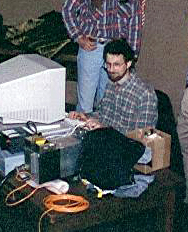
David Lincoln Rabinowitz is an American astronomer, discoverer of minor planets and researcher at Yale University.
Antonio Vagnozzi is an amateur Italian astronomer and a discoverer of asteroids.

The scattered disc (or scattered disk) is a distant circumstellar disc in the Solar System that is sparsely populated by icy small Solar System bodies, which are a subset of the broader family of trans-Neptunian objects. The scattered-disc objects (SDOs) have orbital eccentricities ranging as high as 0.8, inclinations as high as 40°, and perihelia greater than 30 astronomical units (4.5×109 km; 2.8×109 mi). These extreme orbits are thought to be the result of gravitational "scattering" by the gas giants, and the objects continue to be subject to perturbation by the planet Neptune.
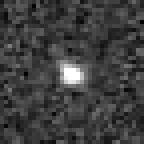
7066 Nessus is a very red centaur on an eccentric orbit, located beyond Saturn in the outer Solar System. It was discovered on 26 April 1993, by astronomers of the Spacewatch program at the Kitt Peak National Observatory in Tucson, Arizona. The dark and reddish minor planet is likely elongated and measures approximately 60 kilometers in diameter. It was named after Nessus from Greek mythology.
(24835) 1995 SM55, provisional designation 1995 SM55, is a trans-Neptunian object and member of the Haumea family that resides in the Kuiper belt, located in the outermost region of the Solar System. It was discovered on 19 September 1995, by American astronomer Nichole Danzl of the Spacewatch program at Kitt Peak National Observatory near Tucson, Arizona, in the United States. It measures approximately 200 kilometers in diameter and was the second-brightest known object in the Kuiper belt, after Pluto, until 1996 TO66 was discovered.

(26308) 1998 SM165 is a resonant trans-Neptunian object and binary system from the Kuiper belt in the outermost regions of the Solar System. It was discovered on 16 September 1998, by American astronomer Nichole Danzl at the Kitt Peak National Observatory in Arizona. It is classified as a twotino and measures approximately 280 kilometers in diameter. Its minor-planet moon was discovered in 2001.
(118228) 1996 TQ66, prov. designation:1996 TQ66, is a resonant trans-Neptunian object of the plutino population in the Kuiper belt, located in the outermost region of the Solar System. It was discovered on 8 October 1996, by American astronomers Jun Chen, David Jewitt, Chad Trujillo and Jane Luu, using the UH88 telescope at the Mauna Kea Observatories, Hawaii. The very red object measures approximately 185 kilometers (110 miles) in diameter. As of 2021, it has not been named.
(118378) 1999 HT11, provisional designation:1999 HT11, is a trans-Neptunian object from the outermost region of the Solar System, locked in a 4:7 orbital resonance with Neptune. It was discovered on 17 April 1999, by astronomers at the Kitt Peak Observatory, Arizona, in the United States. The very red object measures approximately 134 kilometers (83 miles) in diameter. As of 2021, it has not been named.
(35671) 1998 SN165, prov. designation: 1998 SN165, is a trans-Neptunian object from the Kuiper belt located in the outermost region of the Solar System. It was discovered on 23 September 1998, by American astronomer Arianna Gleason at the Kitt Peak National Observatory near Tucson, Arizona. The cold classical Kuiper belt object is a dwarf planet candidate, as it measures approximately 400 kilometers (250 miles) in diameter. It has a grey-blue color (BB) and a rotation period of 8.8 hours. As of 2021, it has not been named.

52975 Cyllarus, prov. designation: 1998 TF35, is a very red centaur, approximately 62 kilometers (39 miles) in diameter, orbiting the Sun in the outer Solar System. It was discovered on 12 October 1998, by American astronomer Nichole Danzl at the Kitt Peak National Observatory near Sells, Arizona, in the United States. It was later named after the mythological centaur Cyllarus.
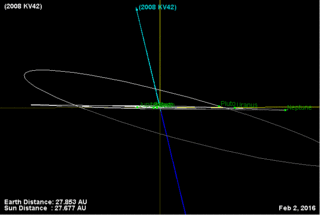
(528219) 2008 KV42 (provisional designation:2008 KV42; nicknamed Drac) is a trans-Neptunian object and the first one with a retrograde orbit to be discovered. This retrograde motion with an orbital inclination of 103° suggests that it is the missing link between its source in the Hills cloud and Halley-type comets, thus providing further insight into the evolution of the outer Solar System. The object measures approximately 77 kilometers (48 miles) in diameter. With a semi-major axis of 42 AU, it takes about 269 years to complete an orbit around the Sun.
(523731) 2014 OK394, also known as 1995 SN55, is a trans-Neptunian object that orbits in the outer Solar System beyond the orbit of Neptune. First observed as 1995 SN55 by Spacewatch on 20 September 1995, it was a lost minor planet with an insufficiently defined orbit with only 36 days of observations. On 8 October 2010, it was rediscovered by the Pan-STARRS 1 survey and later announced as 2014 OK394 in July 2016. It was not until November 2020 when amateur astronomers S. Deen and K. Ly identified 2014 OK394 and 1995 SN55 as the same object. This identification was confirmed and announced by the Minor Planet Center in January 2021.
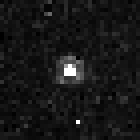
(82075) 2000 YW134, provisional designation: 2000 YW134, is a resonant trans-Neptunian object and binary system, located in the outermost region of the Solar System. It was discovered on 26 December 2000, by astronomers with the Spacewatch survey at Kitt Peak Observatory near Tucson, Arizona. The reddish object stays in a rare 3:8 resonance with Neptune. A smaller companion was discovered by the Hubble Space Telescope in October 2002. As of 2021, neither the primary body nor its satellite have been named.
(55638) 2002 VE95, prov. designation: 2002 VE95, is a trans-Neptunian object from the outermost region of the Solar System. It was discovered on 14 November 2002, by astronomers with the Near-Earth Asteroid Tracking program at the Palomar Observatory in California, United States. This resonant trans-Neptunian object is a member of the plutino population, locked in a 2:3 resonance with Neptune. The object is likely of primordial origin with a heterogeneous surface and a notably reddish color (RR) attributed to the presence of methanol and tholins. It has a poorly defined rotation period of 6.8 hours and measures approximately 250 kilometers (160 miles) in diameter, too small to be a dwarf planet candidate. As of 2021, it has not yet been named.
(457175) 2008 GO98, provisional designation 2008 GO98 with cometary number 362P, is a Jupiter family comet in a quasi-Hilda orbit within the outermost regions of the asteroid belt. It was discovered on 8 April 2008, by astronomers of the Spacewatch program at Kitt Peak National Observatory near Tucson, Arizona, in the United States. This presumably carbonaceous body has a diameter of approximately 15 kilometers (9 miles) and rotation period of 10.7 hours.
12929 Periboea, provisional designation: 1999 TZ1, is a dark Jupiter trojan from the Trojan camp, approximately 54 kilometers (34 miles) in diameter. It was discovered on 2 October 1999, by American astronomer Charles W. Juels at the Fountain Hills Observatory in Arizona. Originally considered a centaur, this now re-classified Jovian asteroid has a rotation period of 9.3 hours and belongs to the 80 largest Jupiter trojans. It was named from Greek mythology after Periboea, mother of Pelagon by the river-god Axius.
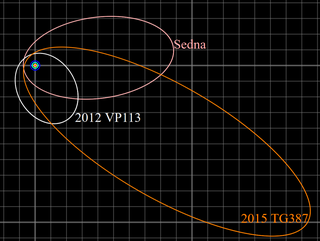
541132 Leleākūhonua, provisionally designated 2015 TG387, is an extreme trans-Neptunian object and sednoid in the outermost part of the Solar System. It was first observed on 13 October 2015, by astronomers at the Mauna Kea Observatories, Hawaii. Based on its discovery date near Halloween and the letters in its provisional designation 2015 TG387, the object was informally nicknamed "The Goblin" by its discoverers and later named Leleākūhonua, comparing its orbit to the flight of the Pacific golden plover. It was the third sednoid discovered, after Sedna and 2012 VP113, and measures around 220 kilometers (140 miles) in diameter.
References
- 1 2 "Minor Planet Discoverers (by number)". Minor Planet Center. September 30, 2021. Retrieved October 12, 2021.
- 1 2 "10720 Danzl". Minor Planet Center. Retrieved October 12, 2021.
- ↑ "Author Page for Nichole M. Danzl :: SSRN". papers.ssrn.com. Retrieved October 12, 2021.
- ↑ "MPC/MPO/MPS Archive". Minor Planet Center. Retrieved October 12, 2021.